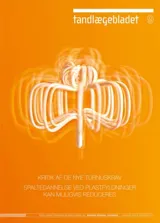Silent sinus syndrom. Præsentation af et patienttilfælde
Silent sinus syndrom er en relativt sjælden forekommende lidelse karakteriseret ved ensidig skrumpning af kæbehulen. Tilstanden forekommer oftest i 30-40-årsalderen og præsenterer sig klinisk ved en volumenforøgelse af øjenhulen og tiltagende nedsynkning af øjet. Ætiologien og patogenesen er ukendt, men menes at kunne udvikles sekundært til kronisk kæbehulebetændelse. Silent sinus syndrom kan behandles konservativt, men den accepterede behandling er funktionel endoskopisk sinuskirurgi, med henblik på at genskabe normale trykforhold i kæbehulen. Rekonstruktion af bunden i øjenhulen foretages ved kosmetiske gener. I nærværende artikel præsenteres en 46-årig mand med silent sinus syndrom, og de behandlingsmæssige samt differentialdiagnostiske overvejelser diskuteres.
Silent Sinus Syndrome. A case study: Silent Sinus Syndrome or chronic maxillary sinus atlectasis is a relatively uncommon condition which is characterized by unila- teral enophthalmos and hypoglobus, due to inward retraction of the maxillary sinus walls and lowering of the orbital floor. The etiology as well as the pathogenesis is unclear, but might be cau- sed by chronic sinusitis. Silent Sinus Syndrome usually occurs in the third and fourth decades of life, and is not gender-specific. The syndrome seems to be under diagnosed in spite of characteristic and pathognomonic clinical and radiological signs. Silent Sinus Syndrome treatment, if any, consists of functional endoscopic sinus surgery to re-establish functional drainage passage and reconstructive procedure of the orbital floor to manage asym- metric facial appearance. A case of a 46-year-old man with Silent Sinus Syndrome is presented.


